Specifications:
Displacement 1,576 t.
Length 175'
Beam 44' 4"
Draft 13' 11"
Speed unknown
Complement unknown
| Click On Image For Full Size Image |
Size | Image Description | Contributed By |
|
|---|---|---|---|---|
 |
52k | Water color on paper by the Canadian artist Edward John Russell (1832-1906) of USS President riding at anchor in a heavy swell. Painting created I January 1904. Currently located at the N.R. Omell Gallery, 6 Duke Street St. James's, London, SW1Y 6BN. | Robert Hurst | |
 |
63k | USS President fires on and disables the British sloop HMS Little Belt, 16 May 1811. Oil on canvas painting by the artist William Elmes | Robert Hurst | |
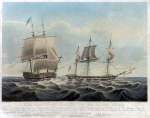 |
339k | USS President and the British sloop HMS Little Belt.
To the Right Honorable Charles Philip Yorke, First Lord of the Admiralty, This Print elucidating the extreme disproportion of Force between the American Frigate President… and His Majesty’s Sloop the Little Belt… London, Dec. 1, 1811. Drawn by Joseph Cartwright / Engraved by John Hassell. |
Robert Hurst | |
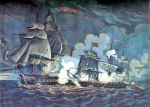 |
118k | Sailing from Annapolis, MD., 12 May 1811, USS President, Commodore Rogers, met and fired on the 20-gun post ship Sloop-of-War HMS Little Belt, Captain. Bingham RN, 15 May 1811.
Painting by William Elmes (1797-1815). Engraved and published by Edward Orme, London, 25 October 1811. |
Robert Hurst | |
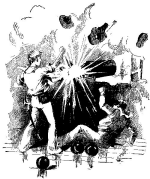 |
118k | Pen and ink drawing of a cannon exploding in USS President during the pursuit of the 36-gun frigate HMS Belvidera.
Creator unknown. Image from "The Naval History of the United States by Willis J. Abbot", Pub. by Peter Fenelon Collier, New York, 1 January 1896. |
Robert Hurst | |
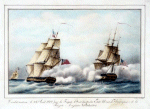 |
42k | Photo of an engraving by De Anger of the battle between HMS Belvidera and USS President, 23 June 1812.
Image can be found at the National Maritime Museum, Park Row, Greenwich, London, SE10 9NF. |
Robert Hurst | |
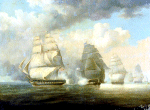
098652211 |
143k | Photo of an oil painting by William John Huggins (1781 – 19 May 1845), depicting the escape of
HMS Belvidera, 23 June 1812.
On the left of the picture Belvidera runs on a very broad reach. She has shot holes in her sails and can be seen firing her stern guns.
Astern of her USS President can be seen repeatedly firing her starboard broadside. To the right of her, and in pursuit, are
USS Congress,
USS United States,
USS Hornet and
USS Argus.
National Maritime Museum, Greenwich, London. BHC0598. |
Robert Hurst | |
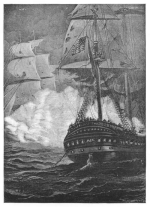 |
59k | "USS President v. HMS Endymion". Creator unknown.
Image from "The Naval History of the United States" by Willis J. Abbot, Pub. by Peter Fenelon Collier, New York, 1 January 1896. |
Robert Hurst | |
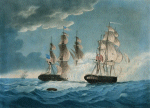 |
80k | A Thomas Butterworth painting depicting HMS Endymion (right) exchanges broadsides with USS President (left) at
around 7:00 pm on the night of January 15th, 1815 when the ships turn to the south and brailed up their spankers in order to exchange broadsides. Circa 1815.
Image courtesy of the New York Historical Society Museum and Library |
Robert Hurst | |
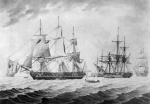 |
40k | A print of an engraving of a Thomas Butterworth painting depicting USS President (left foreground) having surrendered, HMS Endymion (right foreground) is shown without her fore topmast, due to damage she sustained during her duel with President. The painting is entitled "To Captain H Hope... of His Majesty's Frigate Endymion... the Morning after the Action with the American United States Frigate President, January 16th 1814.."; Jeakes, Joseph (engraver); Barr, J, & Bailisar, G (publishers, uncertain). | Robert Hurst | |
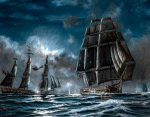
098652210 |
112k | "CHASE OF THE AMERICAN PRESIDENT. OFF NEW YORK, NIGHT OF 15 JANUARY 1815" Limited edition of 250 icicle prints, signed by the artist Joseph Reindler Maritime Artist and numbered. Image size: 16 x 11.2"; overall paper size: 22 x 17.2" (includes 3" cropping) (From an original oil on linen, 27.5 x 40 inches (1000 x 700mm) "Scene depicting fierce action between the US heavy frigate USS President (nearest), Commodore Stephen Decatur, and the British frigate HMS Endymion (left), Captain Henry Hope; the British frigate van of a pursuing squadron also comprising the razee ship-of-the-line HMS Majestic, flag of Commodore John Hayes, and the two other frigates HMS Pomone and HMS Tenedos, Captains John Lumley and Hyde Parker respectively. Commodore Decatur flies his broad pennant, marked “ P R E S I D E N T ”, which is added after detail illustrated in period paintings of the event by British maritime painter, also sailor of the Napoleonic Wars, Thomas Buttersworth. |
Tommy Trampp | |
USS President
Dictionary of American Naval Fighting Ships (DANFS)
| Back To The Navsource Photo Archives Main Page | Back To The Old Navy" Steam and Sail Index |
| Comments, Suggestions, E-mail Webmaster. |
|
This page is created and maintained by Gary P. Priolo |